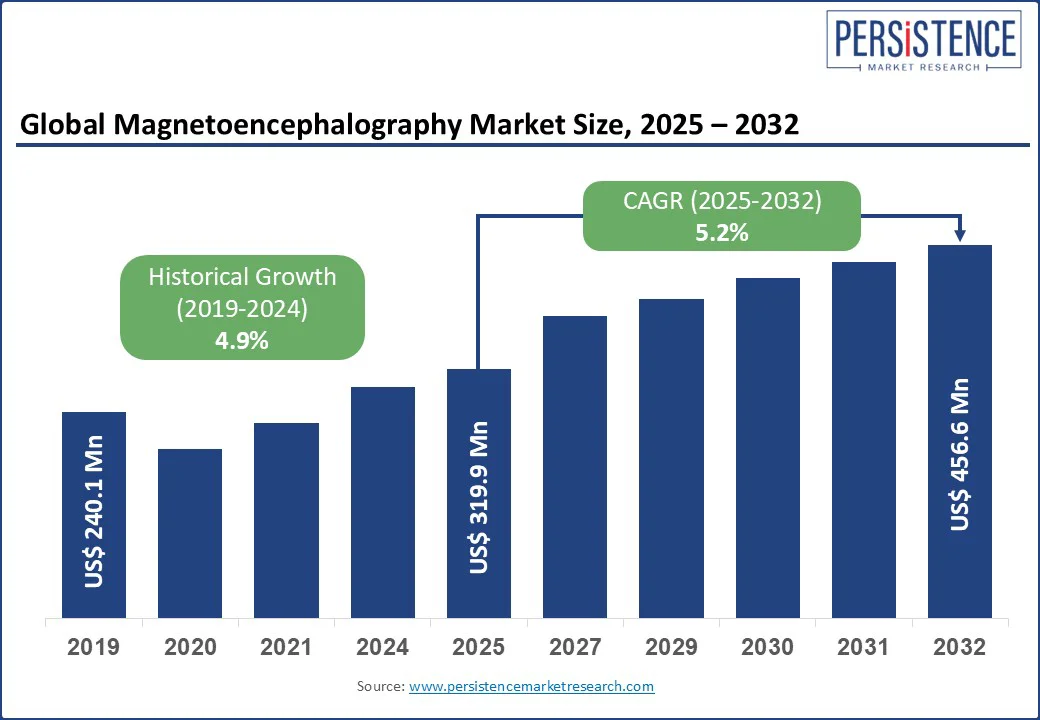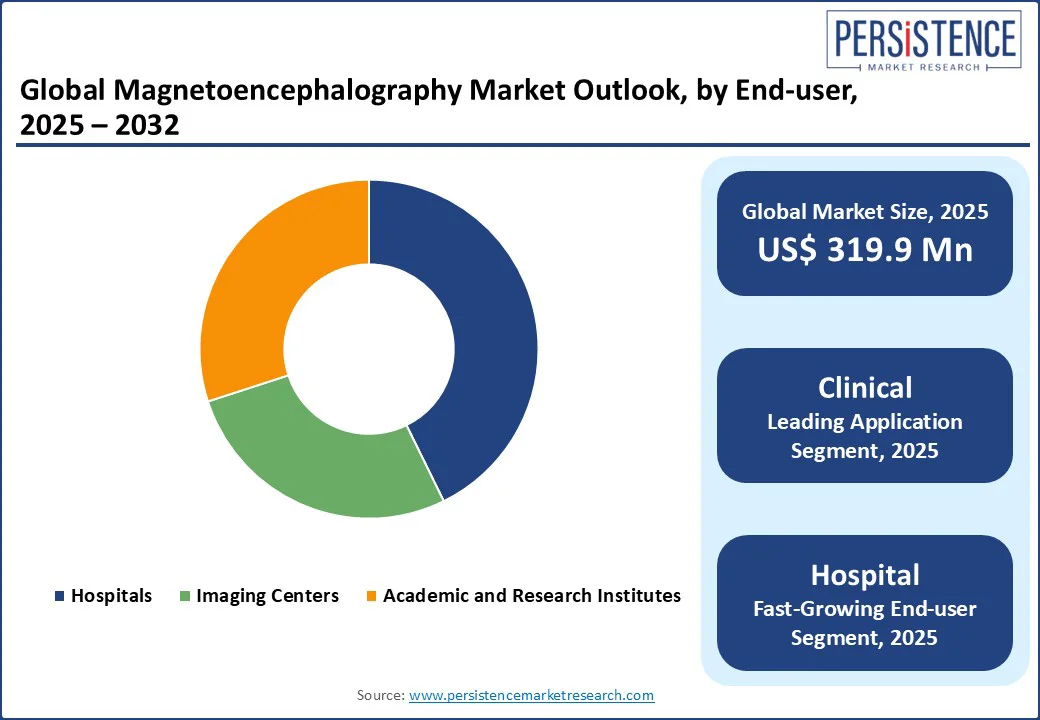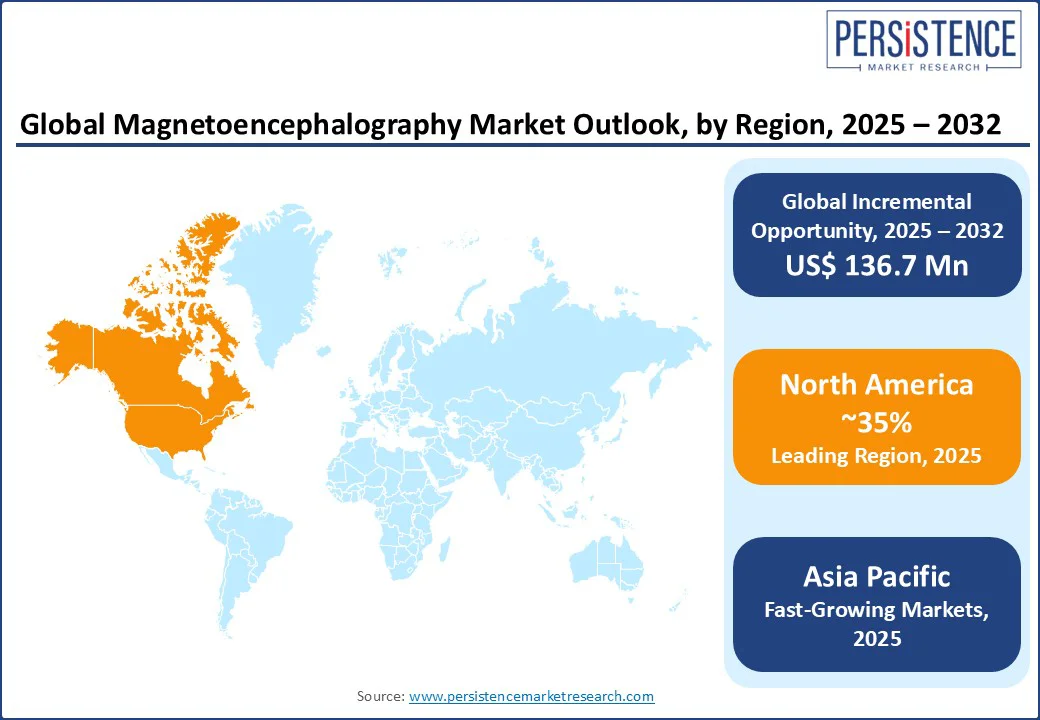ID: PMRREP34730| 185 Pages | 24 Aug 2025 | Format: PDF, Excel, PPT* | Healthcare

The global magnetoencephalography market size is estimated to grow from US$ 319.9 Mn in 2025 to US$ 456.6 Mn by 2032, growing at a CAGR of 5.2% during the forecast period from 2025 to 2032.
The magnetoencephalography (MEG) industry growth is on the rise, fueled by an increasing demand for cutting-edge, non-invasive neuroimaging solutions. MEG systems provide incredibly precise, real-time imaging of brain function, establishing themselves as vital tools in the diagnosis of neurological disorders and the guidance of treatment strategies.
With their unrivalled accuracy and focus on patient safety, these innovative technologies are revolutionizing the field of brain mapping and clinical neuroscience, opening new doors to understanding the complexities of the human brain.
Key Industry Highlights:

|
Global Market Attribute |
Key Insights |
|
Magnetoencephalography Market Size (2025E) |
US$ 319.9 Mn |
|
Market Value Forecast (2032F) |
US$ 456.6 Mn |
|
Projected Growth (CAGR 2025 to 2032) |
5.2% |
|
Historical Market Growth (CAGR 2019 to 2024) |
4.9% |
The rising prevalence of neurological disorders such as epilepsy, Alzheimer's, and Parkinson's is fueling growth in the magnetoencephalography market. As aging populations and lifestyle changes increase, there is a pressing need for advanced diagnostic tools that accurately depict brain activity. MEG offers non-invasive and precise methods, making it vital for early diagnosis and effective management of these conditions.
A 2021 study from The Lancet Neurology, conducted with the World Health Organization, found that over 3 billion people worldwide were living with neurological issues. In response, investments in MEG technology are enhancing its clinical and research applications. Healthcare providers are using MEG to improve diagnoses, guide surgical planning, and deepen their understanding of brain functions, further expanding its role in neurodiagnostics.
The limited availability and high costs associated with magnetoencephalography systems pose significant challenges to the market's growth. Often, this advanced technology is restricted to specialized centers due to the high costs of installation and maintenance, making it difficult for many healthcare facilities to adopt MEG. As a consequence, both patients and researchers experience delays in access, which negatively impacts diagnoses and research opportunities.
Moreover, the requirement for highly trained personnel to operate MEG systems creates a bottleneck, limiting the pool of qualified professionals and discouraging institutions from making investments in this technology. Geographic barriers and a lack of adequate infrastructure in specific regions further exacerbate accessibility issues, particularly for individuals in remote or underserved areas. Tackling these challenges is crucial for fostering the expansion of the MEG market and maximizing its potential for diagnostic and research applications.
The growing global burden of epilepsy offers a real chance for the magnetoencephalography market, notably in drug-resistant cases. According to the WHO, approximately 50 million people worldwide are affected by epilepsy, 80% of these individuals reside in low- and middle-income countries. With the right diagnosis and treatment, around 70% of those suffering from this condition could greatly benefit and improve their quality of life. These same individuals could then live without seizures.
MEG, distinct from typical EEG or imaging, permits accurate, non-intrusive pre-surgical mapping, decreasing the demand for intrusive methods such as intracranial EEG, especially among young patients. MEG adoption is poised to grow since healthcare systems increasingly prioritize precision neurology over diagnosis using minimally invasive methods, especially in developed and emerging economies. MEG is seen as one key technology for advancing neurological care globally because safer and more effective tools are needed in epilepsy diagnosis and for surgical planning.
The clinical application segment leads the MEG market as more healthcare providers turn to non-invasive tools for diagnosing complex neurological conditions. MEG is especially valuable in cases like drug-resistant epilepsy and brain tumours, where precise localization of brain activity can guide surgical planning and improve outcomes.
Its ability to detect subtle, real-time changes in brain function offers a major advantage over traditional techniques. For pediatric patients or those who cannot tolerate invasive tests, MEG provides a safe and comfortable alternative. As awareness of its clinical value grows, MEG is becoming an essential part of modern neurological care.
Hospitals represent the largest end-user segment in the MEG market because they are at the forefront of neurological diagnosis and treatment. Many hospitals are equipping their neurology and neurosurgery departments with MEG systems to offer advanced brain mapping and pre-surgical evaluations.
These systems are especially crucial in comprehensive epilepsy centers and pediatric hospitals, where surgical accuracy is critical. With increasing patient demand for safe, accurate diagnostics and a growing focus on precision medicine, hospitals are prioritizing technologies like MEG to enhance care. Its integration into multi-modal imaging suites makes it a natural fit for hospital environments worldwide.

The MEG market in North America is growing due to strong investments in neuroscience, increasing clinical adoption, and advancements in wearable technologies and AI-driven analytics. Hospitals and research institutes are integrating MEG for early diagnosis and surgical planning. At the 2025 MEG-TREC conference in North America, experts highlighted its potential in detecting early brain disease.
Wearable optically-pumped magnetometers (OPMs), automated biomarker pipelines, and broader insurance coverage are transforming MEG into a standard diagnostic tool for epilepsy, brain tumours, dementia, and TBI. With expanding research collaborations and clinical use, MEG is on track to become central to future neurological care.
European countries are increasingly turning to advanced neuroimaging tools like magnetoencephalography as neurological disorders become a major public health concern. Maurizio Leone presented findings from the Global Burden of Disease Study 2021, revealing that neurological disorders are now the leading cause of disability-adjusted life years (DALYs) globally. In 2025, in the WHO European Region alone, an estimated 449.2 million people will be affected by one or more neurological conditions.
This alarming statistic has pushed countries across Europe to invest in cutting-edge technologies like MEG to improve early diagnosis, guide treatment decisions, and support large-scale brain health initiatives. While national approaches may vary, there's a shared commitment across Europe to strengthen neuroscience infrastructure and integrate tools like MEG into clinical and research settings, making brain health a top priority.
The MEG market in the Asia Pacific is gaining momentum due to rising neurological disorders, growing investment in brain research, and increased adoption of advanced neuroimaging technologies across hospitals and academic institutions.
In 2022, countries such as China prioritized neuroscience innovation to meet growing healthcare demands. A major milestone was achieved with the sale of Compumedics’ Orion LifeSpan™ MEG system to China’s Tianjin Normal University (TJNU), marking the company’s largest contract to date.
Valued at approximately $4.2 million, the installation featured ground-breaking dual-helmet hyper scanning technology, enabling the simultaneous imaging of two subjects. This advancement not only strengthened research at TJNU but also opened doors for broader MEG adoption across Asia.

The key players in the global magnetoencephalography market pursue collaborations and partnerships to develop innovative products and accelerate the grant by regulatory bodies as key growth strategies. Companies are continuously investing in research and development to introduce innovative and break-through magnetoencephalography products.
The global magnetoencephalography market is set to reach US$ 319.9 Mn in 2025.
The magnetoencephalography market is projected to record a CAGR of 5.2% during the forecast period from 2025 to 2032.
Demand for magnetoencephalography is growing globally due to the increasing prevalence of neurological disorders boosts the Meg market growth.
Compumedics Limited, MAG4Health, MEGIN, Brainbox Ltd., Cerca Magnetics Limited, CTF MEG NEURO INNOVATIONS, INC., FieldLine Inc., and Ricoh are a few leading players.
North America is projected to dominate the global magnetoencephalography market in 2025.
|
Report Attribute |
Details |
|
Historical Data/Actuals |
2019 - 2024 |
|
Forecast Period |
2025 - 2032 |
|
Market Analysis |
Value: US$ Mn Volume: Units |
|
Geographical Coverage |
|
|
Segmental Coverage |
|
|
Competitive Analysis |
|
|
Report Highlights |
|
|
Customization and Pricing |
Available upon request |
By Product
By Application
By End-user
By Region
Delivery Timelines
For more information on this report and its delivery timelines please get in touch with our sales team.
About Author